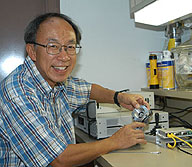 |
|
Joe Wong
|
When Joe Wong looks back on his life, he's convinced his children don't know much about the first 27 years of his life.
That was life before he was married, had three children, two grandchildren and long before he started working in the Chemistry and Materials Science Directorate at DOE's Lawrence Livermore National Laboratory.
Born in Hong Kong, Wong traveled a round-about way to get to Livermore in 1986. At 17, he left Hong Kong to attend high school in Australia. He spent the next 7 years or so there, earning two bachelors degrees in physical chemistry and pure and applied chemistry from the University of Tasmania.
He went on to work at Electrolytic Zinc of Australia for a year and worked nights as a lecturer in physical chemistry at Royal Hobart College, both in Tasmania. He came to the United States and attended Purdue University to earn his Ph.D. in physical chemistry. While at Purdue, he was recruited by GE Research and Development Center to serve as a staff research chemist in its solid state physics laboratory.
But one-third of the way through his career, Wong decided to change his specialty; he was fascinated by the world of synchrotron radiation. He helped build the first X-ray beam line at Brookhaven National Laboratory. At the same time, Livermore was working with Stanford to construct three beam lines for Lab programs. He soon had a job offer from Lawrence Livermore.
Wong's Livermore career has been very successful. He not only has extensive research and development experience in a range of industrial and basic materials science, but his work in synchrotron radiation has earned him much prestige from collaborators and colleagues, domestic and abroad.
In 2003, Wong's team made a landmark event in the history of the experimental investigation of plutonium by mapping the full phonon dispersions of plutonium using an innovative microbeam-on-single-grain technique, ending the quest of this fundamental data for the past four decades or so.
Wong has come a long way from his studies in Tasmania. And by the time his stint at Livermore is over (he retires Jan. 4), he will have published more than 200 papers, earned seven patents, and garnered more than 12 awards from two R&D 100 Awards to the Alexander von Humboldt Research Award for Senior U.S. Scientists. Most recently, Wong was awarded a 2005 fellow of the American Physical Society.
As for life after retirement, Wong plans to enjoy life, smell the roses in his own garden and elsewhere around the globe, fulfill a scroll of items on his and his wife's dream list, but above all, devote as much time as possible to the grandchildren whose photos are plastered all over his office.
Submitted by DOE's
Lawrence Livermore
National Laboratory